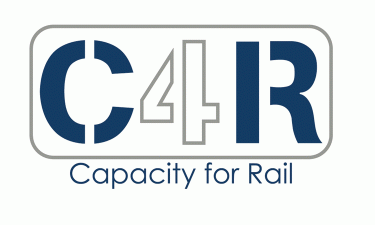Looking towards an affordable, automated and high-capacity railway
Posted: 21 May 2014 | Laurent Schmitt | No comments yet
CAPACITY4RAIL1 is an EU co-funded research project that started at the end of 2013 within the 7th Framework Program and is planned for a total duration of four years. Under the coordination of the UIC, it brings together a wide range of stakeholders in an ambitious partnership. Laurent Schmitt, CAPACITY4RAIL Coordinator at the UIC, provides more details.


Following the White Paper on European Transports published in 20112, CAPACITY4RAIL proposes to bring a system vision of the railways looking towards 2030-2050, by developing new concepts in the fields of infrastructure, freight, operation and monitoring, towards an affordable, resilient, innovative and high-capacity railway system.
The capacity issue is addressed in three different ways:
- A more efficient use of existing resources by optimising operating strategies, enhancing traffic planning, improving transhipment procedures and improving the operational procedures to reduce the time needed to recover from traffic disruption
- A reduction of the non-operational capacity-consumers, through the design of resilient, reliable and low-maintenance infrastructure and vehicles, non-intrusive inspection, fast renewal and construction processes
- An increase of the performance of existing resources, through significant improvements of wagons manoeuvrability and equipment to answer freight customers’ needs for higher reliability and performance.
In order to best address this approach, the project has been broken into the following six sub-projects:
- SP1: Infrastructure
- SP2: New Concepts For Efficient Freight Systems
- SP3: Operation For Enhanced Capacity
- SP4: Advanced Monitoring
- SP5: System Assessment and Migration to 2030-2050
- SP6: Management, Dissemination, Training and Exploitation.
These sub-projects are organised in a container-shaped way, where the transverse sub-project 5 ensures the vision-building and the multi-criteria assessment of the innovative concepts in a comprehensive system view.
Building a vision for 2050
The crucial research and development benefit of CAPACITY4RAIL lays in the systemic and holistic approach to the development of new concepts for future infrastructure, vehicles, communication, and operation technologies.
In its transversal sub-project ‘System Assessment and Migration’, CAPACITY4RAIL is providing the framework for the target-oriented development of new concepts for railway infrastructure, freight and operation, by defining the long-term vision as well as the technologies and short-, mid- and long-term steps. However, the latter will be necessary to enable practical solutions that contribute to the ‘end game’ to be developed and demonstrated.
One of the very first tasks of CAPACITY4RAIL is to define a comprehensive roadmap to describe the necessary steps to develop and implement innovation and to progress from the current state-of-the-art to a shared global vision of the 2050 railway along realistic scenarios.
Five major criteria have been defined that describe the 2050 railway and against which the innovative developments will be assessed. Thus, the future railway system should be:
- Affordable: for the customers and the investors, with limited capital and operational expenditures, minimised life cycle cost and lowest environmental impact
- Adaptable: the railway system will be able to cope with daily, monthly, yearly or seasonal variations of the demand, but will also have sufficient reactivity to adapt unplanned temporary modal shifts.
- Automated: for optimised performance and to help planners respond dynamically to planned and unplanned changes
- Resilient: able to recover not only from major disruptions, but also daily minor perturbations
- High Capacity: a railway with virtually no constraints on operations, that can accommodate customer demand at any time and tolerate interventions with minimal impact.

Infrastructure
Releasing operational capacity from infrastructure through a higher reliability, a lower need for maintenance and an optimisation of maintenance and monitoring procedures have already been a recurrent concern in past projects, such as INNOTRACK3 or AUTOMAIN4, which provided significant advances and concept developments.
CAPACITY4RAIL will keep building on these results and achievements, also considering that significant progress in terms of track availability for running trains and increased resilience will come only through achieving a major breakthrough and step change in the design of a new track system.
The ‘Infrastructure’ sub-project has three research streams: Innovative slab track concepts will be developed with a global total LCC- and RAMS-driven design approach, in view of potential application for mixed traffic, but also for very high-speed, with the following distinctive features:
- Affordability through cost savings in design and construction with prefabricated elements and modular construction techniques
- Advanced maintainability through health monitoring of actual deterioration status and plug-in-place for sub-systems replacement
- Low maintenance through embedded signalling and energy supply
- Resilience to natural hazards mainly from extreme weather conditions including heavy rain and flooding.
The performance of very high-speed track systems will also be given particular attention. The identified limiting factors and obstacles to very high-speed (above 350km/h) will be addressed especially through the development of improved design methodology in terms of vehicle-track interaction and effect of track irregularities on bridges behaviour and settlement issues in transition areas.
At last, switches and crossings are one of the most critical components in terms of reliability and maintenance needs. Basing on failure mode analysis, the CAPACITY4RAIL project will develop breakthrough innovative concepts for switch design solutions including optimised sensor strategies, reduction of stresses and wear and resilience to winter conditions.
Freight
With regard to freight, CAPACITY4RAIL analyses the still existing gaps and bottlenecks which undermine the modal shift of freight traffic to rail and proposes technical and operational solutions for attracting shippers and logistic operators towards a competitive and sustainable rail transport system6.
Considering the most important concerns of shippers with regard to a competitive, frequent, reliable and highly reactive service with continuous flows of information on the transport progress, CAPACITY4RAIL is developing innovative concepts in view of a major evolution of the performance of both combined transport and industrial block trains.
Several technological step changes are considered in the project, including:
- Higher breaking performances allowing better manoeuvrability of freight trains for a better interleaving into mixed traffic
- Automatic coupling and decoupling of wagons, associated with RFID identification for industrialised operations in marshalling yards
- ‘Intelligent’ sensor-equipped wagons allowing faster break testing and continuous monitoring of the wagon condition
- All these innovations supported by fundamental investigations on the vehicles design, structural stresses and wheel/brake shoe contact conditions.
Infrastructure design and operation procedures will inevitably account for these new characteristics of the freight traffic.
Economic assessment of the potential benefits will be carried out and a roadmap to implementation will be drawn to ensure that such innovations are not only affordable but can also be efficiently inserted into the current practice.
Operations
The ‘Operation’ sub-project is building on the on-going ON-TIME EU FP7 project results5, aiming to achieve automated and resilient operations that will enhance capacity on the railways.
The ON-TIME project developed new improved timetabling and real-time traffic management techniques, as well as real-time information to traffic controllers and drivers in order to help maximise the available capacity on the European railway network, decrease delays and improve traffic fluidity.
CAPACITY4RAIL will take the work further and develop what will be decision support systems into automated systems. This will enable the future controllers of the railway to focus on fulfilling the challenges of, for example, running ‘on demand’ train variations in resource allocation and collaborative working within and between countries, an improved efficiency of trans-shipment at nodes, while the systems take care of routine operations and recovery from small or even medium perturbations.
In addition to these developments for a higher level of automation, the ‘Operation’ part of CAPACITY4RAIL is specifying guidelines for emergency and requirements for incident management plans to handle large incidents including those caused by extreme weather.
With the challenge of operating new (and more) traffic and high-performance trains on innovative infrastructures, with improved information flows to drivers and controllers, the ‘Operation’ sub-project will take care of optimising the benefits of the other technological advances of the project.
Advanced monitoring
Squeezing extra capacity by reducing the time available for infrastructure maintenance operations and planning has been the objective of the recently ended AUTOMAIN4 project.
This requires a high level of quality monitoring information in order to have a continuous knowledge of the system condition to carry out the right maintenance at the right time, meaning that monitoring strategies have to be optimised to obtain relevant information when needed that can be cross-correlated with other sources.
Moreover, the monitoring process itself needs to be non-intrusive, i.e. with no impact on operations, and maintenance free.
Monitoring systems currently in use on railways are often designed to proceed with measurements at one time and/or at one specific location.
But outside the railway industry, advanced monitoring technologies are already in use, including low-cost, miniaturised, low-power consuming autonomous sensors, associated with wireless data transmission facilities. Learning from other industries, CAPACITY4RAIL is investigating ways to implement such components into both future and existing infrastructure, and to develop associated strategies for a non-intrusive and highly automated monitoring.
Outputs
Building on previous useable results, the project will deliver both technical demonstrations and system-wide guidelines and recommendations that will be the basis for future research and investment, increasing the capacities of the rail networks in the future.
The development steps and necessary technologies will be mapped against Technology Readiness Levels (TRLs). The success of the project will be demonstrated by the increase of TRLs of key technologies, which will be assessed to identify meaningful demonstrators within the project, the need for further developments in future initiatives or necessary work in follow-up research projects or initiatives such as Shift²Rail.
Conclusion
The work in CAPACITY4RAIL has been designed in such a way to guarantee the greatest interaction between the working groups and ensure results that are relative to the research community and will be deployed in the field.
Whilst the first four SPs will take a top-down approach to the research, by examining the state-of-the-art and working on the key elements that will move the technologies forward, SP5, ‘System assessment and migration’, takes a bottom-up approach and first looks at the boundaries and requirements that exist within the rail system and defines the constraints to the overall system approach.
CAPACITY4RAIL brings together a large range of major active stakeholders of all fields: railway operators; infrastructure managers; track systems suppliers; rolling stock manufacturers; wagon keepers; logistic providers; engineering companies; and research laboratories, all supported by universities on a firm scientific basis. This ensures a deep integration in the railway industry, a full awareness of the customer’s needs and of the system constraints and abilities, as well as an intimate connection to past and on-going research and to future research initiatives.
References
- capacity4rail.eu
- European Commission (2011): White Paper. Roadmap to a Single European Transport Area – Toward a competitive and resource efficient transport system. European Commission, Brussels, 2011.
- INNOTRACK (2010): Innotrack, Innovative Track Systems. Concluding Technical Report. Anders Ekberg & Björn Paulsson, eds. INNOTRACK EU FP 6 project 031415, under the coordination of UIC.
- automain.eu
- ON-TIME (2012): Deliverable D1.1 – Principles, Definitions and Requirements. ON-TIME EU FP7 265647 project, under the cooperation of d’Appolonia.
- Armand Toubol A., Castagnetti F., Olsson B. (2014): CAPACITY4RAIL project. The wagon load activity technology innovations: new freight wagons and trains. Proc. of Transport Research Arena 2014, Paris, 14 –17 April 2014.
Acknowledgements
The author gratefully acknowledges the European Union for funding the CAPACITY4RAIL research project, all the project partners and especially the following individuals who have taken an active part in the elaboration and preliminary description of work for the basis of this article:
- Pierre-Etienne Gautier, Systra
- Bo Olsson, Trafikverket
- Meena Dasighi, Network Rail
- Gunnar Baumann, Deutsche Bahn
- Burchard Ripke, Deutsche Bahn
- Paul Crompton, Arttic


Issue
Related topics
Infrastructure Developments, Track Construction, Track Systems, Track/Infrastructure Maintenance & Engineering








